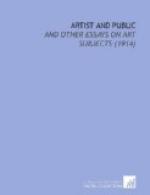Power, fulness, and beauty of coloring are hardly modern qualities. Much as impressionism has been praised for restoring color to a colorless art, its result has been, too often, to substitute whitishness for blackishness. Color has characterized no modern painting since that of Delacroix and Millet as it characterizes much of the best American painting. The love for and the success in color of our school is, after all, a part of its conservatism.
It may seem an odd way of praising a modern school to call it the least modern of any. It would be an odd way of praising that school if its lack of modernness were a mere matter of lagging behind or of standing still and marking time. But if the “march of progress” has been down-hill—if the path that is trod leads into a swamp or over a precipice—then there may be most hopefulness for those who can ’bout face and march the other way. I have, elsewhere in this volume, given at some length some of my reasons for thinking that modern art has been following a false route and is in danger of perishing in the bog or falling over the cliff. If it is so we may congratulate ourselves that those of our painters who are still following the rest of the world have not so nearly reached the end of the road, and that those who are more independent have discovered in time what that end is and have turned back.
It is because it is least that of to-day that I believe our art may be that of to-morrow—it is because it is, of all art now going, that which has most connection with the past that I hope the art of America may prove to be the art of the future.
VII
AUGUSTUS SAINT-GAUDENS[C]
[C] Address delivered before the Brooklyn Institute of Arts and Sciences on February 22, 1908. Now revised and enlarged.
Augustus Saint-Gaudens was born in Dublin, Ireland, on the first day of March, 1848, but was brought to America at the age of six months. His childhood and youth were passed in the city of New York, as was a great part of his working life; and though his origin was foreign, lifelong associations had stamped him indelibly an American. The greater part of his work was done in America; almost all of it was done for America; and I do not think it is fancy that sees in his art the expression of a distinctively American spirit. Yet from his mixed French and Irish blood he may well have derived that mingling of the Latin sense of form with a Celtic depth of sentiment which was so markedly characteristic of his genius.
His father, Bernard Paul Ernest Saint-Gaudens, was a shoemaker from the little town of Aspet in Haute-Garonne, only a few miles from the town of Saint-Gaudens, from which the family must have drawn its origin and its name. His mother was Mary McGuinness, a native of Dublin. Augustus Saint-Gaudens was one of several children born to this couple and not the only artist among them, for his younger brother Louis also




